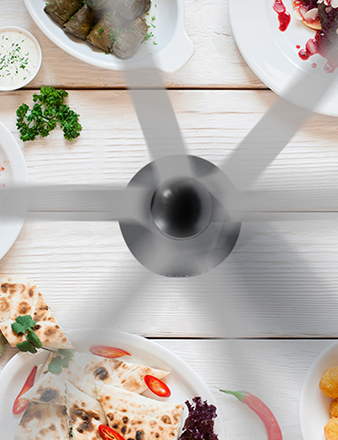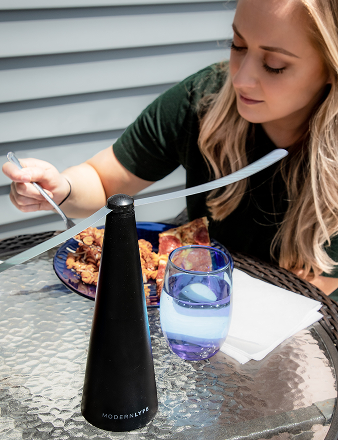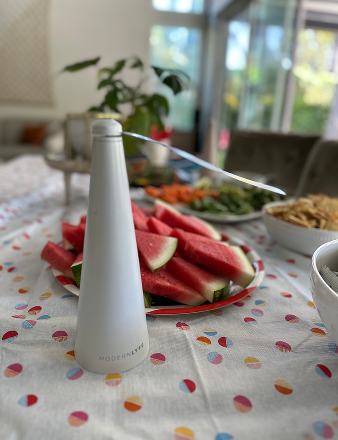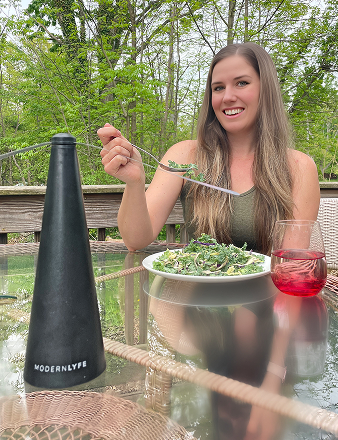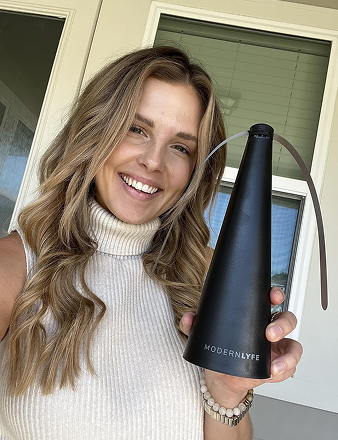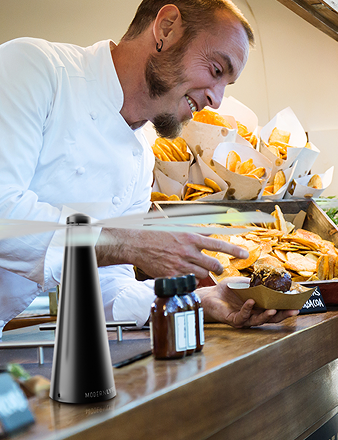The difference between a good camping trip and a great one is your gear. The right accessories add comfort and convenience, handling the details so you can focus on the experience. Your core setup needs a solid shelter, a comfortable sleep system, and a functional camp kitchen. From there, you can add smart gear that improves everything from comfort to safety.
Your Adventure Starts with the Right Gear
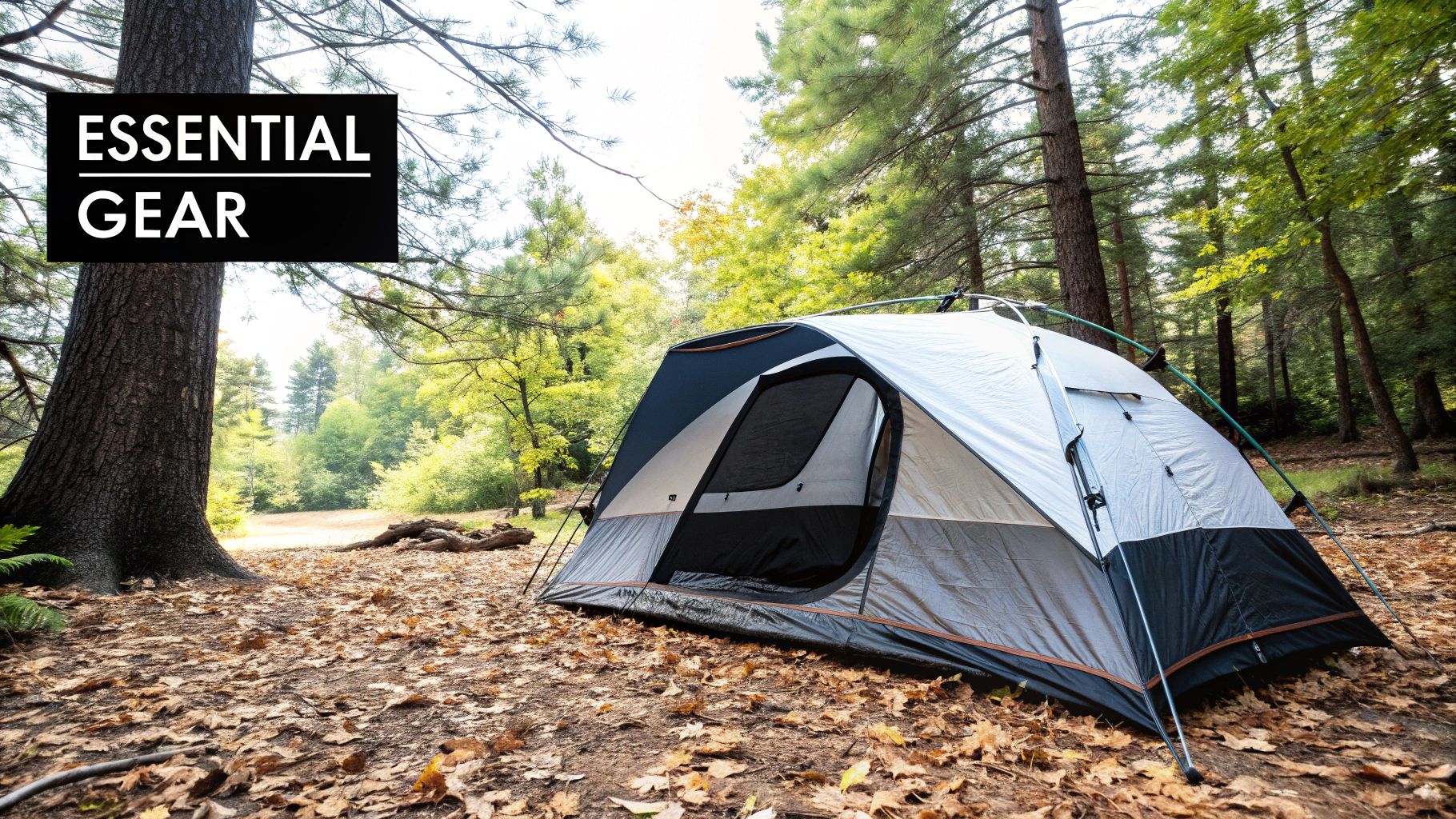
Modern camping is less about roughing it and more about disconnecting from the daily grind to reconnect with nature, friends, and family. Today's gear makes that easier than ever, letting you create a comfortable home away from home. The market reflects this trend. The global camping equipment market was valued at $89.81 billion and continues to grow.
This guide will help you navigate the endless options. We won't just list products. We'll break down the why behind choosing the right gear, focusing on what truly makes a difference in the outdoors.
Core Principles for Choosing Gear
When faced with a wall of camping equipment, it's easy to get overwhelmed. The best way to cut through the noise is to stick to a few simple principles. Every piece of gear should earn its spot in your kit.
Here’s what to look for:
- Portability: How easy is it to pack and carry? Lightweight and compact gear is essential, especially if you have to hike to your campsite.
- Durability: Is it built to last? You need materials that can withstand rain, wind, and general use, trip after trip.
- Functionality: Does it solve a problem effectively? The best gear is often simple and reliable, without unnecessary features.
Stick to these criteria, and you'll build a kit that makes your adventures better. We’ll walk through the essentials, from sleeping setups to cooking equipment, giving you a clear roadmap. For more ideas, our guide on essential camping accessories is a great place to start.
The goal isn't to have the most gear, but the right gear. A few well-chosen, high-quality items will always outperform a trunk full of cheap gadgets. This approach saves you money, space, and stress.
Choosing Your Shelter and Sleep System
Your tent and sleeping bag are your home in the wild. Getting this combination right is the single most important factor for a good night's sleep, which can make or break your trip. Your shelter is your first line of defense against the elements, and your sleep system is your sanctuary inside.
Picking The Right Tent
Choosing the right tent comes down to matching it to your style of adventure.
For drive-up sites, a roomy cabin-style tent is fantastic. They offer high ceilings and near-vertical walls, perfect for families and groups. For more versatility and better wind resistance, a classic dome tent is a solid all-around choice. But if you're heading into the backcountry, every ounce matters, making a lightweight backpacking tent a necessity.
Backpacks are the largest segment of the camping equipment market, with tents and sleeping bags following. You can find more insights about the camping equipment market on IMARC Group.
Decoding Tent Specifications
Don't let technical specs intimidate you. A "seasonality" rating—like 3-season or 4-season—indicates the weather a tent is designed for. A 3-season tent is your standard for spring, summer, and fall, balancing ventilation with rain protection. A 4-season tent is a fortress for winter, built with stronger poles and less mesh to handle heavy snow and high winds.
Waterproofing is measured by a Hydrostatic Head (HH) rating. A rating of 1500mm is waterproof enough for most rain showers. For serious storms, look for a rating of 3000mm or higher for complete protection.
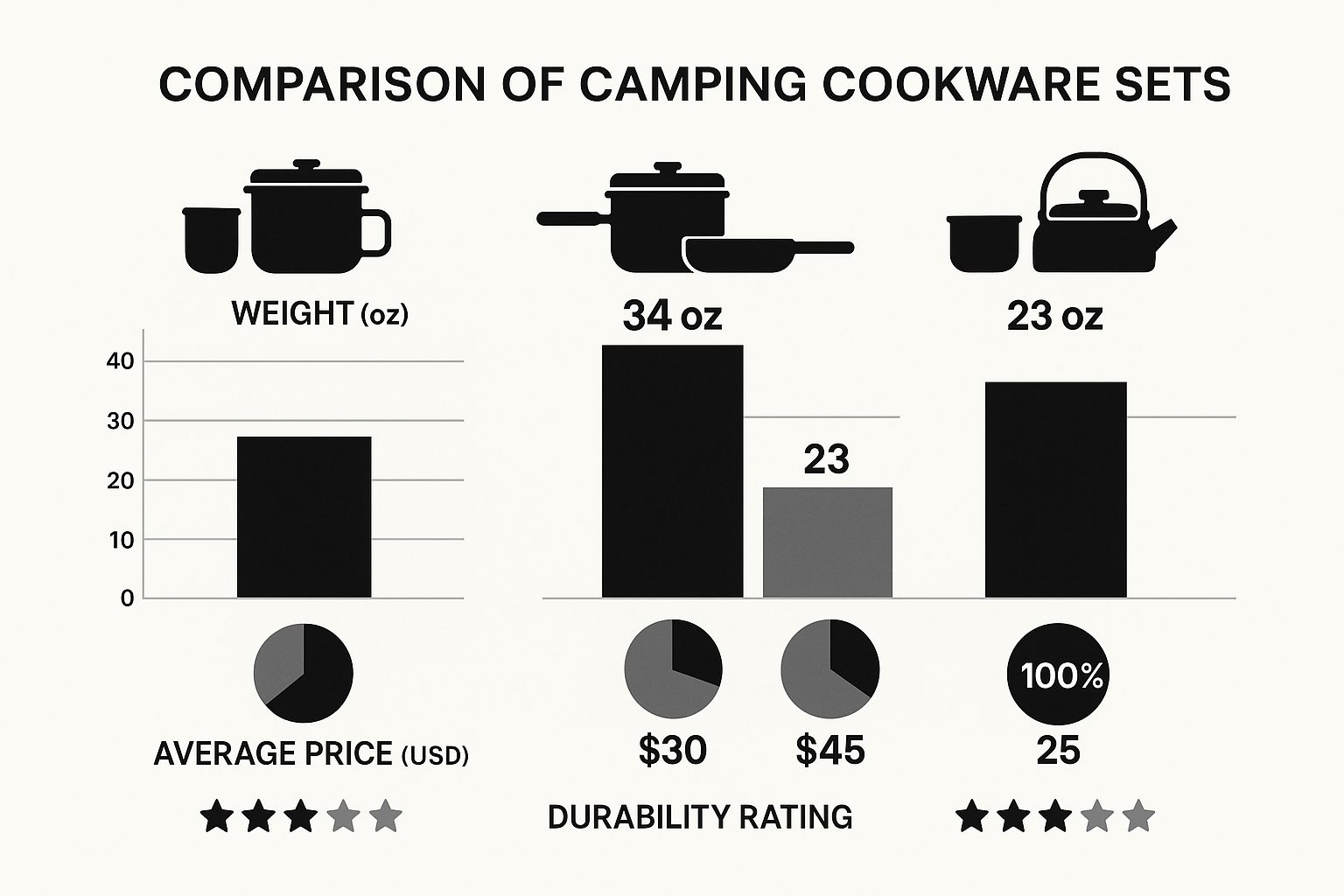
Building Your Perfect Sleep System
Once your shelter is sorted, it's time to build your sleep system. This is a team of three working together: the sleeping bag, the sleeping pad, and an optional pillow. Each part is crucial for keeping you warm, comfortable, and well-rested.
Your sleeping bag is your primary source of warmth. You'll face one key decision:
- Down Insulation: Incredibly lightweight and compressible, offering the most warmth for its weight. The main drawback is that it loses its insulating ability when wet and is typically more expensive.
- Synthetic Insulation: Retains warmth even when damp, making it a reliable choice. It's also hypoallergenic and more affordable. The trade-off is that it’s heavier and bulkier than down.
Your sleeping pad is just as important as your sleeping bag. It’s what insulates you from the cold, hard ground. A bag's temperature rating is tested with a pad, so skipping it means you won't get the warmth you're expecting.
The sleeping pad is the final piece of the puzzle, providing both cushioning and insulation from the ground, which rapidly draws heat from your body. Here's a look at the main types.
Camping Sleeping Pad Comparison
This table breaks down the three main types of sleeping pads to help you decide which is the best fit for your camping style.
| Pad Type | Comfort Level | Insulation (R-Value) | Portability & Weight | Best For |
|---|---|---|---|---|
| Closed-Cell Foam | Low to Medium | Low (1-2.5) | Ultralight & Bulky | Thru-hikers, budget campers, and as a backup pad. |
| Self-Inflating Pad | Medium to High | Medium to High (3-7) | Moderate Weight & Size | Car camping and backpackers prioritizing comfort. |
| Inflatable Air Pad | High | Varies (1-8+) | Very Lightweight & Compact | Backpackers where weight and space are critical. |
Ultimately, choosing the right pad requires balancing comfort, weight, and warmth. Pairing the perfect pad with your bag completes your sleep system, ensuring you wake up refreshed and ready for the day.
Mastering Your Campsite Kitchen
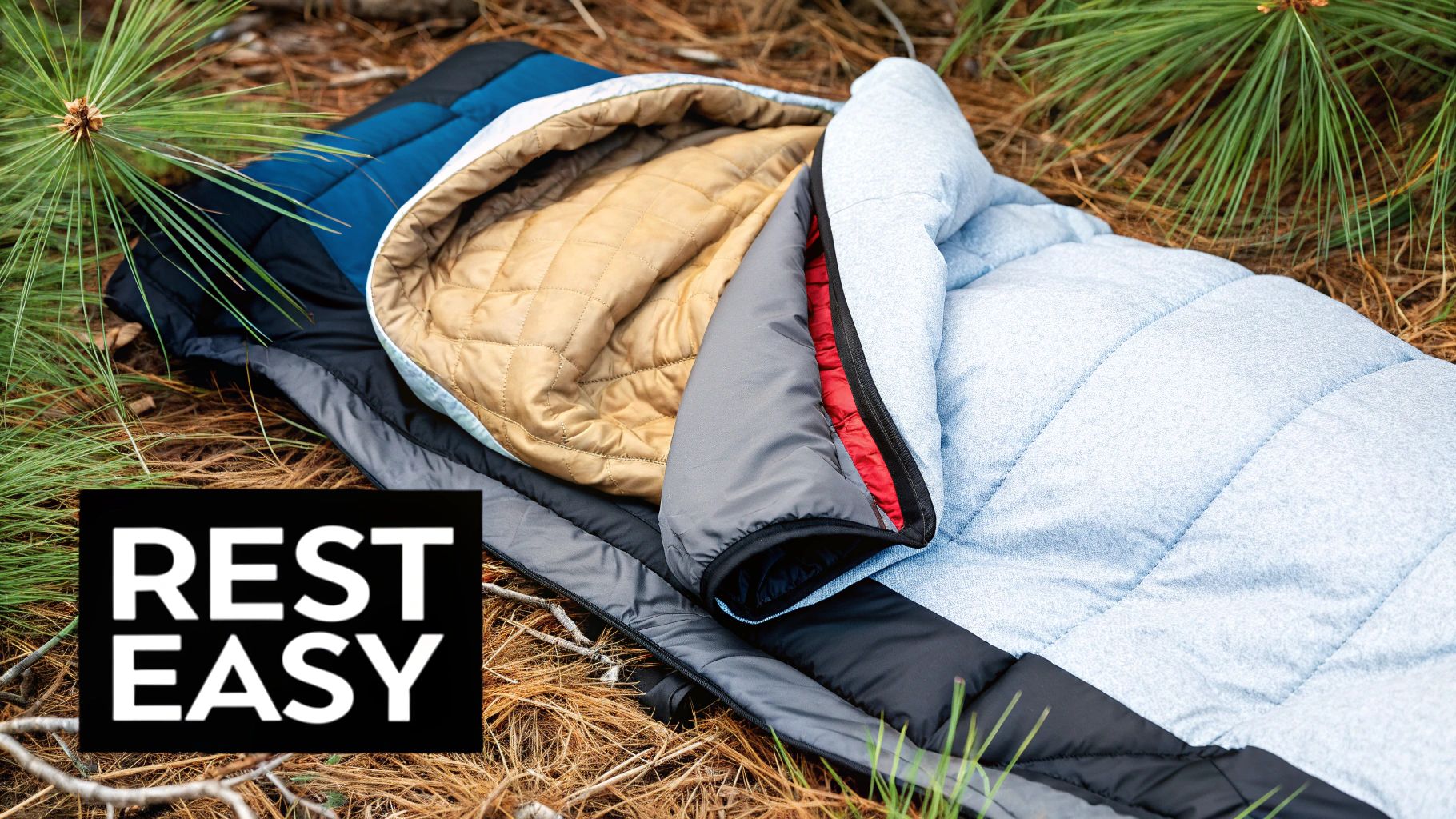
A fantastic meal can turn a good camping trip into an unforgettable one. A functional campsite kitchen isn't about packing everything; it's about choosing the right tools for the job. Every camp meal, from morning coffee to dinner under the stars, relies on a dependable heat source and a safe supply of water.
The stove is the centerpiece of any outdoor kitchen. Your first decision is the fuel type, which dictates how the stove performs.
Choosing Your Portable Stove
A portable stove is an essential camping accessory. For beginners or those who value convenience, propane canister stoves are ideal—just screw on the canister and start cooking. For cold-weather camping, isobutane blends perform much better as temperatures drop. Liquid fuel stoves are the workhorses of the group. They are the most versatile, performing well in freezing conditions and at high altitudes, but they require more maintenance.
For most car campers, a simple two-burner propane stove is the best choice. It feels like cooking at home and provides plenty of space. If you enjoy grilling, you can upgrade your menu with dedicated Weber BBQ grill accessories that simplify outdoor cooking.
The right cookware is just as vital as the stove itself. Don't haul your home kitchen gear to the campsite. Invest in a dedicated set designed for the outdoors to save space and weight.
Essential Cookware and Hydration
Once you have a heat source, you need the right pots and pans. For backpackers, this means ultralight titanium or aluminum pots that nest together to save space and weight. For car campers, nothing beats the performance of a classic cast iron skillet. It's durable, heats evenly, and is perfect for anything from pancakes to steak.
Beyond cooking, safe drinking water is non-negotiable. Dehydration is a serious risk outdoors, and drinking directly from a stream can expose you to harmful bacteria and protozoa. A reliable water treatment system is a critical piece of your safety kit.
You have three main options for treating water:
- Filters: These physically strain out contaminants like bacteria and protozoa. They are fast, effective, and great for removing sediment.
- Purifiers: These go a step further, using chemicals or UV light to eliminate viruses that filters might miss. A purifier is essential for international travel or areas with questionable water quality.
- Gravity Systems: Ideal for groups. These systems use a large water bag connected to a filter hose. Fill the bag, hang it from a tree, and let gravity treat several liters of water with zero effort.
Upgrading Your Campsite Comfort and Vibe
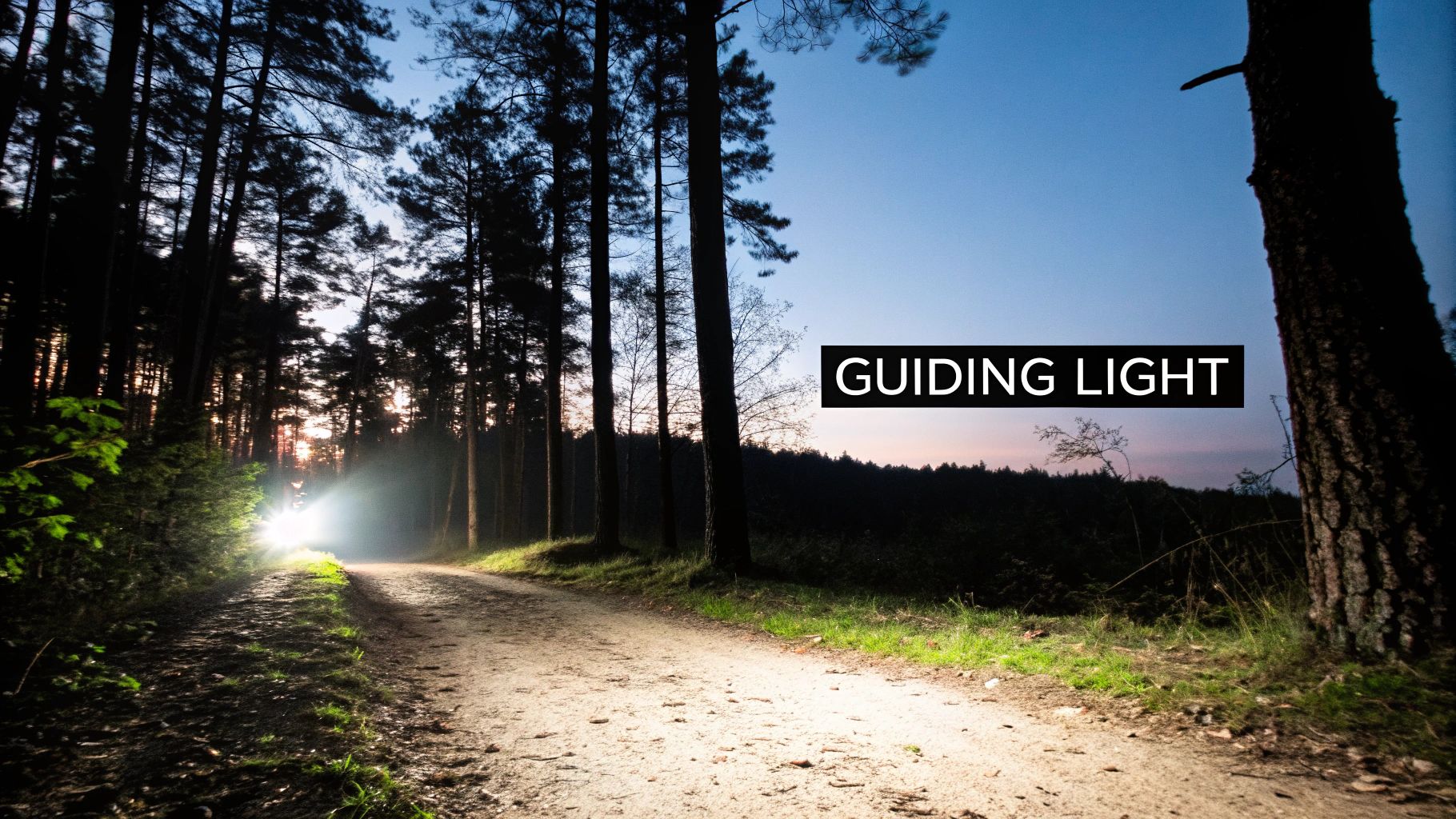
Once the tent is pitched, it's time to turn a spot in the woods into your personal outdoor getaway. The right gear isn't just about survival; it's about thriving. It elevates a trip from just sleeping outside to truly relaxing and recharging in nature.
Think of your campsite as an outdoor living room. You wouldn't settle for an uncomfortable chair at home, so why do it outdoors? The goal is to bring pieces that are both practical and enjoyable, creating a basecamp you want to return to after a long hike.
Building Your Outdoor Living Room
It all starts with a good place to sit. A quality portable camping chair is essential. Look for something with solid back support that won't tip on uneven ground. While compact stools work for backpacking, car campers can opt for more comfortable chairs with armrests, cup holders, and even a recline feature.
Next is a reliable camping table. This simple item becomes the center of your campsite, holding everything from card games to your meal prep station. When choosing one, balance packability and stability. Roll-top aluminum tables pack down small, while sturdy folding plastic tables offer a perfectly level surface.
For ultimate relaxation, add a hammock. It’s the definition of outdoor leisure. There’s nothing better than stringing one up for an afternoon nap or reading a book. Look for a model made from lightweight, durable nylon that includes its own suspension system for easy setup.
Choosing the right comfort gear is about maximizing your relaxation time. The best accessories are the ones you can set up in minutes, allowing you to spend less time fussing with gear and more time soaking in the scenery.
Setting The Mood With Campsite Lighting
Good lighting is about more than just seeing after dark; it sets the mood for the evening. A smart lighting setup uses layers of different light sources to create a warm, welcoming space. Many of these tools are also useful for daytime events; see our guide to essential accessories for a picnic for more ideas.
Here are three lighting essentials:
- Headlamps: This is your go-to for any task requiring two hands, like cooking in the dark or late-night trips to the bathroom. Get one with adjustable brightness and a red-light setting to preserve your night vision.
- Lanterns: This is your area light, casting a soft glow over your main campsite. Modern LED lanterns are efficient and safe, and many include features like a dimmer or a USB charging port.
- String Lights: For pure vibe, nothing beats string lights. A simple strand instantly makes any campsite feel cozy and magical. Battery-operated or solar-powered versions are easy to hang from a tree or tent, transforming your site with a warm glow.
Essential Safety and Navigation Tools
The best gear is often the gear you pack but hope to never use. Being prepared for the unexpected is what separates an experienced camper from a novice. It’s the difference between a minor inconvenience and a serious problem. Your most important accessories are your safety net.
First, a well-stocked first-aid kit is non-negotiable. Don't just grab a pre-made one. Customize it for your destination and activities. Heading to the desert? Add extra blister care and tweezers. Camping by a river? Include insect sting relief and waterproof bandages.
Your safety gear is an insurance policy for your adventure. You invest a little time and space preparing it, and in return, you get the peace of mind to fully enjoy your trip, knowing you’re ready for what comes your way.
Navigating Your Adventure
Even on a clearly marked trail, it's easy to get turned around. One wrong turn can lead to another, which is when reliable navigation tools become critical. The smartest approach is to bring both traditional and modern tools.
- Map and Compass: These tools never run out of batteries. Learning to read a topographic map and use a compass is a fundamental outdoor skill. They are your most reliable backup and connect you to your surroundings in a way a screen cannot.
- GPS Devices: A dedicated handheld GPS is more robust than a smartphone. They are built for durability, have excellent battery life, and can acquire a signal where phones fail, providing pinpoint accuracy for route tracking.
- Satellite Messengers: For trips far from cell service, these devices are a lifeline. They allow you to send check-in messages and, most importantly, have an SOS button to summon emergency services in a crisis.
The Ultimate Problem Solvers
Beyond navigation and first aid, a few items can solve countless problems at the campsite. A solid multi-tool is like a toolbox in your pocket, useful for everything from tightening a loose screw on a camp chair to opening a can.
The same applies to a good camp knife. It’s an essential workhorse for preparing food, cutting cordage, or making kindling. Campers demand reliable gear, which is why the market for these dependable tools continues to expand with new technology. You can see how much this space is growing by checking out the latest camping equipment market trends at Fortune Business Insights.
By packing these core items, you aren’t just planning for worst-case scenarios. You're giving yourself the confidence to handle whatever the wilderness throws at you.
Putting It All Together: Your Camping Gear Checklist
We've covered some excellent gear. Now, let's ensure you remember to pack it. A checklist is the best way to avoid leaving something critical at home.
Think of this as a blueprint, not a rigid set of rules. Tweak it for your specific adventure, whether it's a weekend car camping trip or a multi-day backcountry trek. If you're driving to a campsite, you can bring heavier, more comfortable items. For backpacking, every ounce matters, so focus on ultralight and multi-purpose gear.
Shelter and Your Sleep System
This is your foundation for a good night's sleep.
- Tent: Ensure it’s the right size for your group and appropriate for the expected weather.
- Sleeping Bag: Check the temperature rating to ensure it’s warm enough for the conditions.
- Sleeping Pad: This is essential for both comfort and insulation from the cold ground.
- Pillow: A small inflatable or compressible pillow provides a touch of luxury.
Camp Kitchen and Hydration
A good setup for cooking and drinking makes a campsite feel like home.
- Portable Stove & Fuel: The heart of your outdoor kitchen. Don't forget the fuel.
- Cookware & Utensils: A simple pot, pan, and utensil set are all you need.
- Cooler: Essential for keeping food fresh and drinks cold.
- Water Filter or Purifier: Non-negotiable for safe drinking water.
- Reusable Water Bottles: Bring a couple to stay hydrated throughout the day.
A piece of advice: investing in durable gear from the start saves money and frustration. Quality equipment withstands years of use, making it a smarter choice than constantly replacing cheap items that break.
Answering Your Top Camping Gear Questions
Entering the world of camping gear can feel overwhelming. Let's tackle some of the most common questions from new and experienced campers.
The biggest question is always, "Where do I start?" The answer is to ignore the flashy gadgets and focus on your core needs: shelter, sleep, and food.
For your first few trips, you need a solid tent for the expected weather, a comfortable sleeping bag, and a sleeping pad for insulation. Add a headlamp, a basic first-aid kit, a small stove, and a water filter, and you have a base kit that will serve you well on most adventures.
Is More Expensive Gear Always Better?
It's a common trap to assume a higher price tag means better quality. The "best" gear is simply what works for you. An ultralight titanium stove is ideal for a backpacker counting every gram but impractical for a family that car camps.
The real goal is to find gear that's reliable, does its job well, and fits the way you like to camp. Don't pay for high-tech features you'll never touch when a simpler, more durable option will do.
A heavy-duty, affordable cast iron skillet is far better for cooking over a campfire than a flimsy backpacking pan. Similarly, there's no need to buy a four-season expedition tent if you only camp on sunny summer weekends.
Down Or Synthetic Sleeping Bags?
This is a classic debate, and the right answer depends on your destination and budget. Each has clear pros and cons.
-
Down Insulation: The lightweight champion. Nothing beats down for its warmth-to-weight ratio and compressibility. Its main weakness is that it's expensive and loses all insulating properties when wet.
-
Synthetic Insulation: The reliable workhorse. It stays warm even when damp, making it a safer choice for wet climates. It's also more affordable but is heavier and bulkier.
Ultimately, choosing the right accessories is about making practical decisions based on your specific needs.
Ready to keep your campsite comfortable and pest-free? The Modern Lyfe fly fan is the perfect accessory for any outdoor meal. Discover how this elegant solution can elevate your dining experience and make sure the only guests at your table are the ones you invited.

